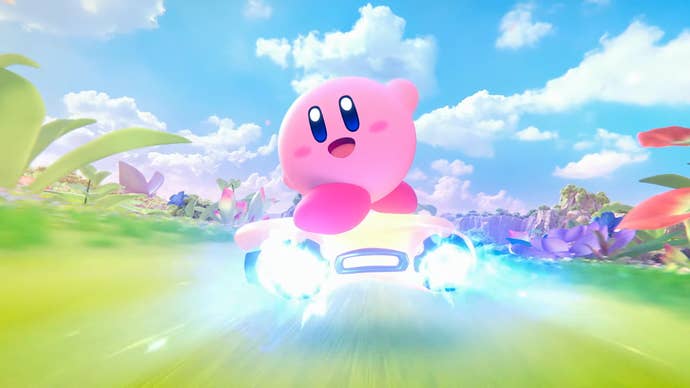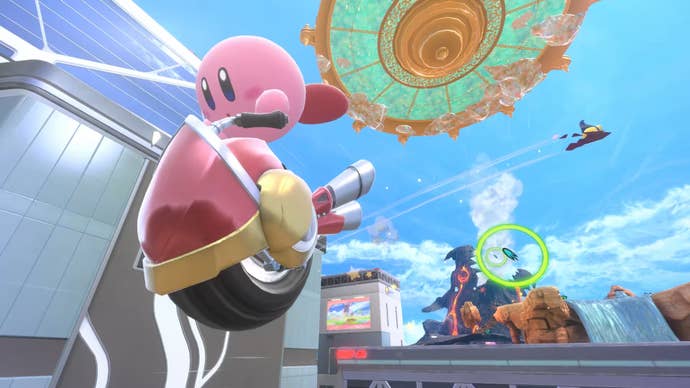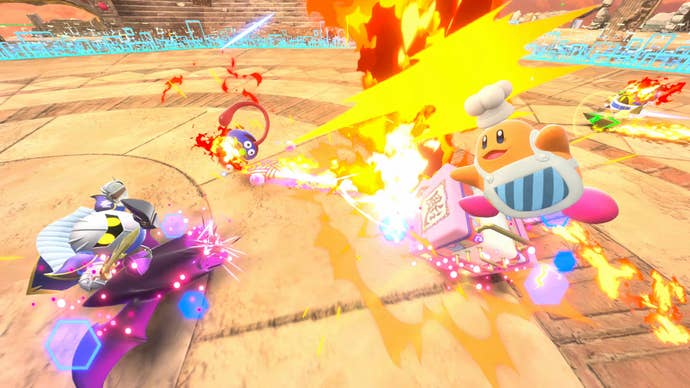Let’s kick off with a confession: I never really rated 2003’s Kirby Air Ride. I’m well aware that some regard it as a GameCube classic, but I’m not one of them. When a sequel, Kirby Air Riders, closed out the big Switch 2 blow-out Nintendo Direct, my reaction was rather apathetic. A sequel to that is their grand finale?
It’s classic Nintendo that all it took to win me around was a way-too-detailed Nintendo Direct broadcast and a quick 30-minute hands-on. I get it now. Not why some people loved the original so – that knowledge still eludes me – but I now understand why Nintendo and Super Smash Supremo Masahiro Sakurai wanted to make another one of these. As the Direct cheekily needled, this could be seen as being a lot like Mario Kart. But really, in truth, it has more in common with Smash.
Kirby Air Riders is a strange little thing. It’s simple, as demonstrated in its easy-to-discern objectives and a control scheme that requires only a handful of buttons to operate. With that said, it has its ways in which it is complicated – at the hands-on, Nintendo had a chaperone quickly run each player through a handful of tutorials amidst a menu replete with them, clearly concerned that some players might struggle to wrangle or understand its esoteric ways.
This whole dichotomy is very much Sakurai’s jam. These are the fingerprints of a man who designed one of the most competitively sublime fighting games of all time… sort of by mistake. Melee’s tightest brawling was a byproduct of making a party game for children that, through glitches, exploits, and mechanics interacting in unexpected ways became a hyper-competitive dream. Even if Sakurai’s instinct has been to design away from that with every Smash Bros game since, that same predilection for a mash-up of surface simplicity and hidden complexity rears its head here.
What is in a sense clearly intended to be a breezier racer than the manic euphoric highs and brutal blue-shelled lows of Mario Kart is elevated and transformed by a search for depth that doesn’t compromise that accessible core.

Hop into Air Rider courses and you get the simplicity. It is after alls a circuit race with six competitors on track, automatic acceleration, and walls that keep you from going too far off-course. It feels fluffy and friendly – like Kirby. The controls add to that; all you really need to know is that the left stick steers you left and right and the B button brakes. That’s all a kid will need to ‘get through’, so to speak – but there is of course more to it than that.
Each of the control mechanisms is then subtly layered; the stick can also point the nose of your machine up or down, which can become vital for pulling off more complex moves. Braking and turning hard into a corner allows for a slight drift; holding the brake charges a boost. The courses are deliberately built to wind and weave with plenty of corners, and it’s in drifting and boosting through these that you can still have some control over your top speed in a game with automatic acceleration.
There’s more beyond this, of course – capturing enemies, special attacks, even items. But the fundamentals are that simple race design. The largest augment comes in the stats of the various vehicles and riders, which isn’t something all that new to this experience. Mario Kart and Sonic Racing Crossworlds both have such a mechanic, for instance – but in Kirby Air Riders, the effects feel like they can ultimately end up more profound.
To fully appreciate that, the easiest thing to do is to hop over to City Trial mode. This was present in the GameCube original and always espoused by that game’s defenders as its secret weapon – and it rather feels like that’ll be the case here, too. While the cheery-but-fun track racing worked well enough for me, City Trial is where I really locked in – and where I truly ‘got it’.

In City Trial, you and other players are dropped into a small open zone, able to drive freely for a limited time as items, enemies, and frenzied events spawn all around you. Your goal is to put together a good ‘build’ before the clock hits zero, which is accomplished by picking up power ups that appear all over the place. You can even swap vehicles – known in this game as machines – or sabotage and battle other players for domination of power-up collection. It very quickly gets manic.
City Trial really showcases the strengths of the parameters each character and vehicle has naturally by absolutely smashing them to pieces. The nine categories of power-up you pick up augment your top speed, acceleration, offensive and defensive capabilities and so on, plus how hardy your vehicles are before they explode. The idea is essentially to garner as much power as you can in the City Trial time limit before being thrown into a mini game where you’ll use your powered-up form to compete to be the ultimate winner.
At this point it doesn’t really feel like a racing game. You can sense Sakurai’s sensibilities bubbling up, peeking through cracks in the genre design. City Trial is to a racing game as Smash is to a fighting game, in a sense. It is… except it isn’t. Except it is.
As you jet around the City Trial area, a mastery of the mechanics becomes vital. Braking to a sudden stop to avoid obstacles or fellow players, boosting to get to items before rivals, blasting off ramps and then working to stay aloft with careful gliding in order to collect parcels of airborne power-ups… like I say, you begin to lock in.

You need that feeling, too. That trance-like state where there’s you, the game, and everything else fades away. Because the power-up drops are random, though you have some degree of control over what you pick up you’ll also be making split-second decisions. What sort of vehicle ‘build’ am I going for here? More speed? Better gliding? Suddenly, amidst the chaos, you’re doing rapid-fire, almost subconscious decision-making. A lot of it is by feel, too – rather than looking at stats of what you’ve picked up you’re instead judging the feel of those super-simple controls, the heft of your machine, its turning circle, its acceleration and braking – then making calls on what else it needs.
If you’re efficient at collecting power-ups (and at the risk of blowing my own trumpet, I was very efficient), you can more or less break the game. A Nintendo rep was shocked at the sheer number of speed power-ups I picked up – the game became difficult to control, such was the pace of my vehicle. The camera freaked out.
I could then understand why Air Riders, which is relatively visually unremarkable, makes sense on Switch 2 – it needs to be able to parse such ridiculous speed and intense visual frippery. In the end, I had to ditch my naturally-quick vehicle and swap to one that was inherently slower in order to counteract the frankly bonkers amount of speed I was able to deploy. One can also see how, when compared to GameCube, this is a game that’ll benefit tremendously from online play.
I love stuff like this. City Trial is five minutes of total mayhem that does indeed evoke a similar feeling to Smash. It’s followed by a randomly-drawn mini-game where the larger number of City Trial participants get split into groups of four who then compete to be the ultimate winner. The stats accrued throughout City Trial will play a huge part in how that game plays out. If you’re unlucky your build might even work against you, so it’s not necessarily that the person who does the best in the City Trial wins.
Anyway, it’s fun. It’s wild. It feels breakable, which you can see as either a good or a bad thing, I suppose. Everything is turned up to eleven, from the deluge of tutorial options for such a simple game to the chaos that can unfold in City Trial.
All of this might sound familiar to those who loved the GameCube original – but there’s just something different here. Something more. Perhaps it’s the case that the original was simply the template and proof-of-concept for what a Kirby Racer-turned party game can be – and Air Riders might, two decades later, be the full expression of that idea. We’ll find out how far these ideas can truly be stretched in November.







